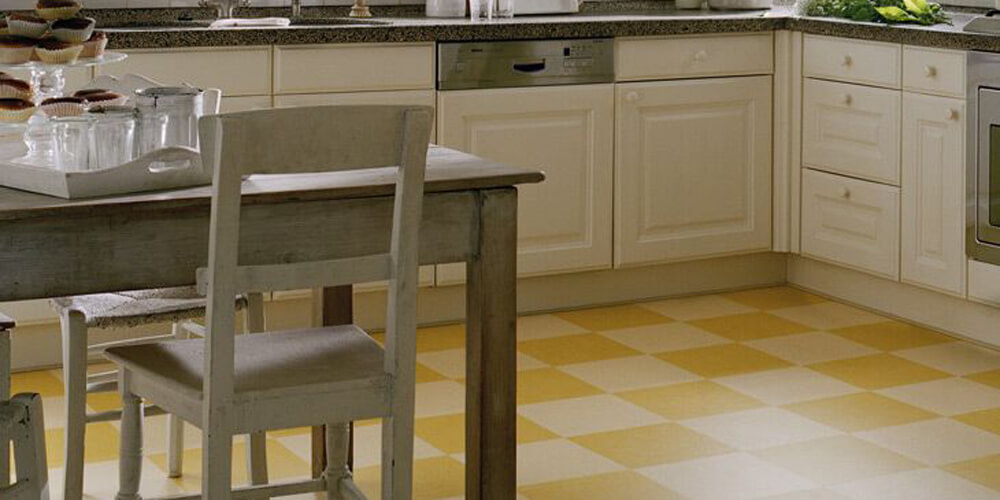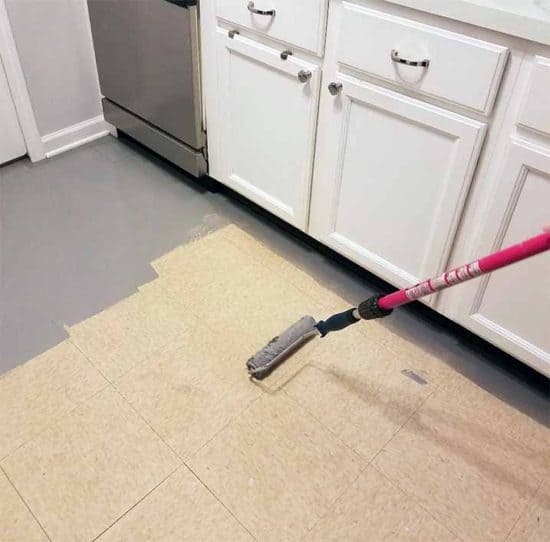
All interior design must include flooring since it has the power to create or ruin a room. The first physical interaction any person gets to make with your area is with the flooring, even if our first encounter with a space is visual. It provides the framework for your design and ultimately has an effect on how successful it is. Flooring has always been very important for interior designing of any home. If you paint linoleum floor, it would look spectacular.
Linoleum flooring can be a durable and affordable option for your home, but it may not always fit with your aesthetic preferences. Instead of replacing it, you can give your linoleum floor a makeover by painting it. In this step-by-step guide, we’ll show you how to paint linoleum floor and transform the look of your space.
What is Linoleum Floor?
Linoleum is a type of resilient flooring that is made from natural materials such as linseed oil, wood flour, cork dust, and ground limestone. It is a popular flooring option due to its durability, affordability, and sustainability. Linoleum is a material that comes in a wide range of colors and patterns, making them versatile options for different interior design styles. Linoleum flooring is also easy to maintain and clean, which makes it an ideal choice for high-traffic areas such as kitchens, bathrooms, and entryways. It is a great flooring option for homeowners who want a durable and eco-friendly flooring solution.
The problem with this or any other surface is that they get dull with over time. Wear and tear is a very big problem; however, with this material, you can easily take care of this problem. You can resolve this problem at home by yourself with a few tools and materials. You will love the end result if you follow the method provided in this article. The steps are easy, and you don’t need to be an expert to get the job done.
This material is cost-efficient and durable, and refurbishing this material is also easy. This is the reason it is getting popular among the people. In the US and other countries, people prefer this material because they can easily make it look new with few steps. Follow us till the end to learn about the painting process of the Linoleum floor and how you can do it yourself easily.
What is the Painting Process for the Linoleum floor?

Painting a linoleum floor involves applying a fresh coat of paint to the surface of the linoleum flooring to give it a new look. Linoleum is a durable and affordable flooring option, but over time, it can become faded, scratched, or outdated. Painting the linoleum floor is an easy and affordable way to update the look of your flooring without the cost of replacing it. With the right tools and techniques, painting linoleum surfaces can be a fun and rewarding DIY project.
You don’t need to call in experts to help you out with it; anyone at home with the right tools can do it themselves. You will need to purchase the right tools first and then follow a simple process to update your dull and unattractive floor at home. People prefer this material to use inside their house because they can easily update it and look attractive by themselves. The painting procedure is simple and like applying paint to any other thing. If you have ever had a painting experience or not, you can easily do it. First, complete the tools and materials you need, and then get to work.
Materials You Will Need
To work this DIY out, you will need some material. Without proper material painting the floor is an impossible task. So to get the most out of the floor, utilize the following materials and improve your dull flooring. You will require the following material to Paint Linoleum Floor:
- Trisodium Phosphate (TSP)
- Sandpaper (120-grit)
- Vacuum cleaner
- Painter’s tape
- Primer
- Paint
- Paintbrush
- Roller
- Paint tray
- Clear polyurethane sealer
A Step-by-Step Guide to Paint Linoleum Floor

It is rather a simple and easy process, a few steps, and your house will look new as a bride. If you want your house to look new and don’t want to spend much on them, follow the steps given below. We will take you through each step and provide tips to ease up the process for you:
Match Colors
Matching the color is an important step when painting a linoleum surface. It’s essential to select the right color and paint type that will adhere well to the linoleum surface. The best way to ensure a proper match is to bring a small sample of the linoleum to the paint store and have the paint technician help you find the closest color match.
It’s also a good idea to test the paint on a small, inconspicuous area of the surface before proceeding with the full project to ensure that the color is a good match and that the paint adheres well to the surface. If you forget to match the color before applying it, then it can be a big problem, so ensure that you have the same color and then move to the next step.
Clean and Prepare the Floor
Start by cleaning the linoleum floor thoroughly; you will need to prepare it to start the process. Use a vacuum cleaner to remove any dust and dirt. Use the vacuum to clean the surface properly, and use thorough cleaning to remove all dust particles. Check, and once done, apply the mixture.
Mix trisodium phosphate (TSP) with water and scrub the surface with a scrub brush to remove any remaining grime. Rinse the surface with clean water and let it dry completely. Don’t hurry; let it dry, or the paint won’t work, so let it dry completely. If you have start fans, let them dry quickly and then begin the next process.
Sand the Floor
You will need to sand it for the next step; you will need 120-grit sand paper, which is available at any hardware store. Using sandpaper with a 120-grit, gently sand the linoleum floor to roughen the surface. You can use a sanding machine to do the process; if you do it by hand, it will take a very long time, and you will tire as well.
This will help the primer and paint adhere better. After sanding, vacuum the surface again to remove any dust. You don’t need to clean it with water after the sanding process; a vacuum is enough. Clean it thoroughly and move to the next step in line.
Tape off the Edges
In a DIY, there are a lot of chances for things to go wrong, so you must take precautions. This step can be regarded as a precaution. You will need painter’s tape for it. Apply painter’s tape to the edges of the floor to protect the baseboards and walls from paint splatters. If anything goes wrong during the work, there is some protection for the baseboards and the wall. So, you can be a little relaxed while working. It also reduces the risk of things going wrong. Once done, get to the next step.
Prime the Floor
In this step, you will need t to apply primer to the surface. Primer is a pre-coat if you don’t know. It is applied before applying paint. The job of this pre-coat is to ensure adhesion and increase the life of the color. So, if you want the color to stay in its place for a long time, you must do this process on the surface.
Apply a coat of primer to the linoleum floor using a paintbrush or roller. Make sure to apply an even coat. It is very important to apply a very smooth and even coat to get better results. The next process will start once the primer dries, so let it dry completely before proceeding to the next step.
Paint the Floor
Once the primer is dry, it’s time to paint the linoleum floor. Choose a high-quality floor paint that is designed for use on linoleum. Use a paintbrush or roller to apply an even coat of paint to the entire floor. Use a light hand while applying the coat; this will ensure an even coating on the surface. Even coating is important if it will not look good.
Let the first coat dry completely before applying a second coat. You will need to apply more than one coat to get the desired look, so repeat this step until you achieve the desired color and finish. Once you have the desired finish, you will need to move to the next and final step. Remember to let it dry after applying each coat.
Seal the Floor
Once the final coat of paint has dried completely, apply a clear polyurethane sealer to the entire floor to protect the paint and make it more durable. This is a very important step, and it will decide how long this new flooring will last. Make sure to follow the manufacturer’s instructions and allow the sealer to dry completely before walking on the floor. Use the tools preferred by the manufacturer to get the desired results.
Conclusion
Paint linoleum floor yourself; it is an affordable and easy way to update your space. With the right materials and techniques, you can transform your flooring and give your home a fresh, new look. Follow this step-by-step guide and enjoy your newly painted linoleum surface. Don’t miss any step, or you will ruin the whole thing, read and follow each step closely to ensure a good finish.


